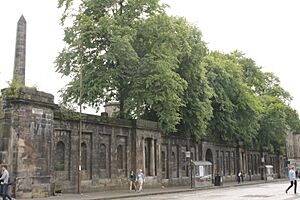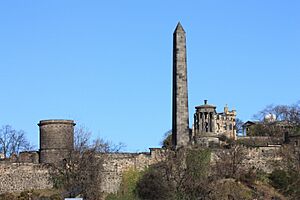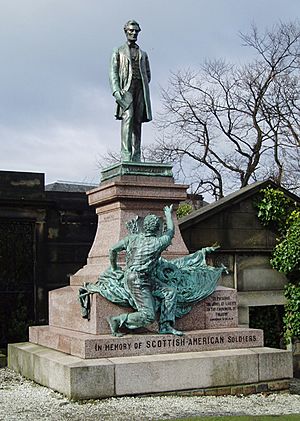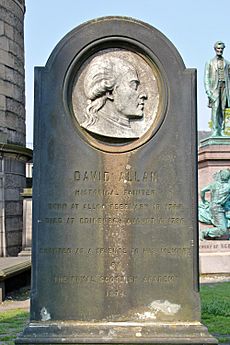Old Calton Burial Ground facts for kids
 |
|
| Lua error in Module:Location_map at line 420: attempt to index field 'wikibase' (a nil value). | |
| Details | |
|---|---|
| Established | 1718 |
| Location |
Calton Hill, Edinburgh
|
| Country | Scotland |
| Type | Public |
| Owned by | City of Edinburgh Council |
The Old Calton Burial Ground is a historic graveyard in Edinburgh, Scotland. You can find it near Calton Hill, just northeast of the city center. This burial ground first opened in 1718. It is the final resting place for many famous Scottish people. These include the philosopher David Hume and the scientist John Playfair.
The graveyard also holds the Political Martyrs' Monument. This is a tall stone pillar built to remember political reformers. It is also home to Scotland's American Civil War Memorial. In 1819, a new road called Waterloo Place was built. This road cut the graveyard into two parts. The City of Edinburgh Council now looks after Old Calton, along with other old graveyards in Edinburgh. The burial ground and its monuments are protected as a special historic site.
Contents
- History of Old Calton Burial Ground
- Important Monuments and Burials
- The Political Martyrs' Monument
- Scottish-American Soldiers Monument
- Tradesmen's Gravestones
- David Allan, the Painter
- David Hume, the Philosopher
- Captain John Gray's Gravestone
- John Leishman McDougall VC
- John Haig, the Whisky Maker
- Dr Robert Candlish, the Church Leader
- Thomas Hamilton, the Architect
- Daniel Stewart, the School Founder
- William Blackwood, the Publisher
- Archibald Constable, the Book Collector
- Robert Burn, the Architect
- John Playfair, the Scientist
- Peter Williamson, "Indian Peter"
- Images for kids
History of Old Calton Burial Ground
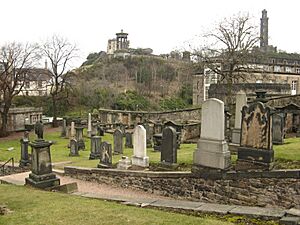
The people living in Calton village used to bury their dead far away. This was at South Leith Parish Church. Because it was so far, they needed a closer place. So, in 1718, a group called the Society of the Incorporated Trades of Calton bought some land. They paid £1013 for half an acre. This land was to be their new burial ground.
They also got permission for a road to the burial ground. This road is now called Calton Hill. The Society of the Trades of Calton made the burial ground bigger several times. People stopped being buried here in 1869. But the Society kept control until 1888.
How Waterloo Place Changed the Graveyard
A new road, Waterloo Place, was planned in 1814. It was built between 1815 and 1819. This road went right through the graveyard. Many bodies and gravestones had to be moved. This was done very carefully. Bones were gathered and moved to New Calton Burial Ground. This new burial ground is about 0.5 kilometers to the east. Some of the larger old gravestones were also moved there. This is why you might see 18th-century stones in a 19th-century cemetery.
Because of the road, a small part of the graveyard is now separate. It is on the north side of Waterloo Place. You can reach it from Calton Hill street. A building next to it was once the meeting place for the Incorporated Trades of Calton. It was built after their old meeting rooms were knocked down for the new road.
The Jewish Burial Ground
In 1795, a Jewish dentist named Herman Lion asked the Edinburgh Town Council for a small piece of land. He was German and had moved to Scotland in 1788. Jewish people could not be buried in Christian graveyards. The Council agreed to give him land on Calton Hill for seventeen pounds. An old map from 1852 shows this spot. It was called "Jews' Burial Vault (Lyons Family)". It was just outside the north wall of William Henry Playfair's City Observatory.
Important Monuments and Burials
Old Calton Burial Ground has many interesting monuments. They tell stories of famous people and important events.
The Political Martyrs' Monument
In 1793, some people from a group called The Friends of the People were put on trial. This group wanted everyone to have the right to vote. They were charged with "sedition" and "treason". This meant they were accused of trying to cause trouble against the government. Their real "crime" was pushing for voting rights for all, not just landowners. These men became known as the Chartist Martyrs.
Thomas Muir of Huntershill was their leader. He and four others were sent away to Australia. This happened on August 30, 1793. The huge stone pillar, or obelisk, in the graveyard is for them. It was designed by Thomas Hamilton, who is buried nearby. This monument is a main feature of Old Calton. It was likely chosen because the graveyard was not linked to any church. It also has a very visible spot.
The monument's inscription says:
To the memory of Thomas Muir, Thomas Fyshe-Palmer, William Skirving, Maurice Margarot, and Joseph Gerrald, erected by the Friends of Parliamentary Reform in England and Scotland 1844.
I have devoted myself to the cause of the people, it is a good cause – it shall ultimately prevail – it shall finally triumph – speech of Thomas Muir in the Court of Justiciary on the 30th August 1793. I know that what has been done these two days will be re-judged – speech of William Skirving on the 7th January 1794.
The goal of these reformers was finally achieved with the Scottish Reform Act 1832. The men were pardoned in 1838. The monument was built about 50 years after their actions. It was inspired by the changes their fight helped bring about.
Scottish-American Soldiers Monument
The American Civil War Memorial is also called the Scottish-American Soldiers Monument. It was dedicated on August 21, 1893. It honors Scots who fought and died in the American Civil War. The monument shows Abraham Lincoln standing. A freed slave is kneeling at his feet, giving thanks. This monument is a key feature of the graveyard. It stands right in front of David Hume's tomb.
This is the only monument to the American Civil War outside the United States. It was also the first statue of a US president outside America. It is the only statue of Lincoln in Scotland. The sculptures were made by George Edwin Bissell. The stonework was done by Stewart McGlashan & Son. A bronze shield shows the old US flag. It is surrounded by thistles (for Scotland) and cotton (for the American South). Two rolled-up flags show that the battle is over. The Black man holds a book, showing he is now free and educated.
This monument was paid for by Americans. It honors a small group of Scots. They fought for the Union (the North) in the American Civil War. Only one, William Duff, is buried under the monument. The others are buried nearby. The inscription says: "To preserve the jewel of liberty in the framework of Freedom." This is a quote from Abraham Lincoln.
The people remembered here are:
- Sergeant Major John McEwan
- Lt Col William L. Duff (died of wounds after returning to Edinburgh)
- Robert Steedman
- James Wilkie
- Robert Ferguson
- Alexander Smith (added in 1993 after research)
The idea for this monument came from the widow of Sergeant Major McEwan. She wrote a letter to the United States government.
Tradesmen's Gravestones
Some 18th-century gravestones for local tradesmen are very interesting. They have detailed carvings. The largest one belongs to John Morton, a heelmaker. He died in 1728 at age 54. His stone has a fancy frame with a triangular top. It shows a crest with two lions. Two carved female figures stand on either side, holding an open book.
Another stone from 1762 has a skull and the words "Memento Mori". This means "Remember you must die." It also shows an hourglass on its side, meaning life has stopped. There are crossed bones and tools for digging graves. These symbols remind us that everyone will die. This stone is for Margrat Thomson, who died in 1760.
David Allan, the Painter
The painter David Allan (1744–1796) showed artistic talent from a young age. He was even kicked out of school for drawing funny pictures of a teacher! He was known as "the Scottish Hogarth". He drew pictures for books like The Gentle Shepherd and many of Robert Burns' works. His grave was not marked for a long time. In 1874, almost 80 years after he died, the Royal Scottish Academy put up a headstone. It has a small picture of his face made by John Hutchison.
David Hume, the Philosopher
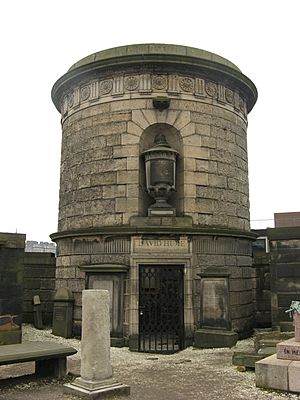
David Hume (1711–1776) was a famous historian and philosopher. He wrote Treatise of Human Nature. He was well-known across Europe in the 1700s. He was a very important person in the Scottish Enlightenment. He influenced many other thinkers, like Adam Smith. However, his grave had to be guarded for eight days after he was buried. This was because many people disliked him. He openly said he did not believe in God.
In his will, Hume asked for a simple monument. It should only have his name and the years he was born and died. He wanted "Posterity to add the Rest." His tomb is a large round tower that you can see from many places in Edinburgh. It was designed by Robert Adam in 1777. Hume was not religious, which is why he was buried in this non-church graveyard. But other family members were religious. His niece is also buried here. She added a Christian message to her part of the tomb.
Captain John Gray's Gravestone
Captain John Gray put up a very well-carved stone for his parents around 1760. It is still in great condition. Many people think it is the most interesting stone in the whole graveyard. It has his name and a carved anchor. Below that is a carving of a three-masted ship. On the left side of the stone, there is a skull and a man's bearded head. This might be his father. Ribbons from the mouth link to symbols of death: a scythe (a tool for cutting crops, often linked to death) crossed with a spear, and crossed bones. On the right side, there is a woman's head, likely his mother. Ribbons from her hat link to more symbols of death: a spade (a digging tool) crossed with a coffin, and more crossed bones.
John Leishman McDougall VC
This is a newer stone for John McDougall (VC) (1840–1869). He was a soldier who won the Victoria Cross. This is a very brave award. He got it for going into the Taku Forts during the Second China War. Sadly, his medal was later stolen from his home. No one knows where it is now.
John Haig, the Whisky Maker
The Scottish distiller John Haig is buried here. Several members of the Haig whisky family are also here. John Haig was important because he helped make whisky popular. This happened when wine and brandy sales went down in the late 1800s. He helped create blended whisky. He also turned whisky making in Scotland into a big industry. His family business later became United Distillers. John Haig was the father of Field Marshal Lord Douglas Haig, a famous leader from World War One. However, Lord Douglas Haig is not buried here.
Dr Robert Candlish, the Church Leader
Dr Robert Candlish (1806–1873) was a church leader. He was a key figure in the Disruption of 1843. This was when 470 ministers left the Church of Scotland. They had different ideas about how the church should be run. Dr Candlish and Rev Thomas Chalmers started the Free Church of Scotland. Dr Candlish wrote many religious books. He became the leader of the Free Church in 1861.
When the Free Churches split, their members could no longer be buried in the old churchyards. Many new Free Churches were in cities and did not have burial grounds. So, most Free Church members had to use other graveyards. Dr Candlish chose this traditional, non-church graveyard. His gravestone does not mention his achievements.
His father, James Candlish, was a medical teacher in Edinburgh. He is also buried here. James was a friend of Robert Burns. Burns once called him "the earliest friend... that I have on earth."
Thomas Hamilton, the Architect
Thomas Hamilton (1784–1858) was a famous architect. He designed many important buildings in Edinburgh. These include the Royal High School and the Bank of Scotland. He also helped start the Royal Scottish Academy (RSA) in 1826. His monument is fairly new. There is a bronze plaque with his picture on the back wall of his family tomb. Students from the Royal High School put it there in 1929. Interestingly, he also designed the Martyrs' Monument, which is very close to his grave.
Daniel Stewart, the School Founder
Daniel Stewart (1741–1814) started Daniel Stewart's Hospital. This was one of Edinburgh's top schools. It later became Daniel Stewart's College. Then it joined with another school to form Stewart's Melville College. His tomb is sealed and has a heavy wooden door.
William Blackwood, the Publisher
William Blackwood (1776–1834) was a publisher and a judge. He started the Edinburgh Encyclopedia and Blackwood's Edinburgh Magazine. He was also Sir Walter Scott's publisher for many years. His tomb is a closed vault with a fancy iron gate.
Archibald Constable, the Book Collector
Archibald Constable (1774–1827) was a book collector and publisher. He was a rival of Blackwood. He also published Walter Scott's books. Constable started collecting books when he was young. By age 21, he had his own bookshop. He began his publishing career in 1798. He started Farmer's Magazine (1800) and took over the Scots Magazine (1801). He also started the Edinburgh Review (1802) and got the rights to publish the Encyclopædia Britannica (1812). This large, simple monument has a bronze head of him. It shows his death date but does not list his achievements.
Robert Burn, the Architect
The architect Robert Burn (1752–1815) designed Nelson's Monument on Calton Hill. His large family tomb does not mention his work. He was a respected architect. His sons, William and John Burn, were also famous architects. John is buried here too, but without a special memorial. The monument itself was designed by his first son, William Burn.
John Playfair, the Scientist
Professor John Playfair (1748–1819) was an important mathematician and scientist. He was the brother of architect James Playfair and engineer William Playfair. He was also the uncle of architect William Henry Playfair. He was a close friend of James Hutton. His grave was not marked at first. A plaque was put there in 2011. Playfair's main monument, designed by William Henry Playfair, is on Calton Hill, not on his grave. You can see it from the north part of the graveyard.
Peter Williamson, "Indian Peter"
Peter Williamson (1730–1799), known as "Indian Peter," had an amazing life. He was born near Aberdeen. When he was 13, he was kidnapped and sold into slavery. He is one of the few known examples of early white slave trade. Peter escaped and lived with Native Americans for some years. This is how he got his nickname.
He returned to Scotland and successfully sued the Aberdeen Town Council for their part in his enslavement. This made him quite wealthy. He then started several businesses. One of the most notable was Edinburgh's first Penny Post in 1773. This was a postal service that delivered letters for a penny. It was linked to one of the world's first street directories. He is buried in the Scott family grave with his daughter, Agnes Williamson Scott. However, Peter Williamson's name is not on the monument.
Images for kids


